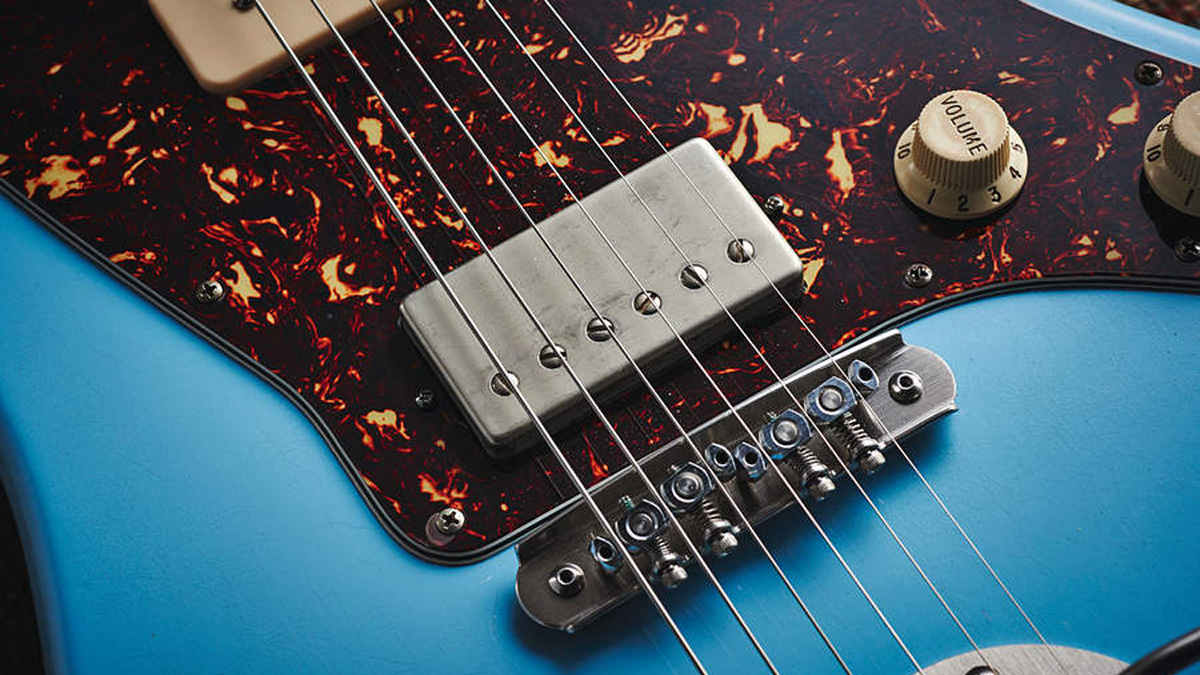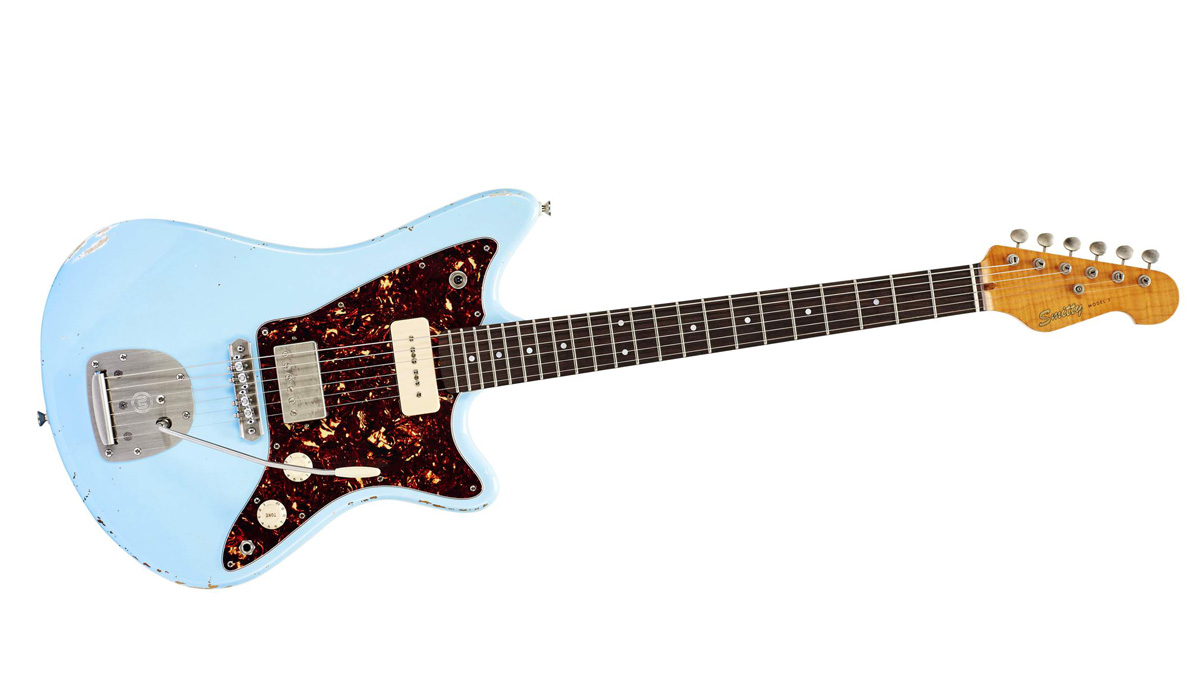MusicRadar Verdict
A fantastic build. You really should experience this.
Pros
- +
Original take on Jazzmaster style with very different voicing and a great vibrato unit.
- +
Superbly crafted.
- +
Great neck.
Cons
- -
You’ll need to maintain the neck, but the resulting feel is wonderful here.
MusicRadar's got your back
Eric ‘Smitty’ Smid started playing guitar in his teens during the mid-70s, inspired by discovering the late Jimi Hendrix.
He started his nickname-based custom guitar company nearly a decade ago: based in Nieuw-Vennep, a few kilometres south west of Amsterdam, Eric builds primarily bolt-ons with the occasional set-neck design, with the help of his son. “I’m more of a ‘Fender’ guy,” he tells us. “It’s always been Strats and Teles that were my first guitars. Jimi Hendrix, Rory Gallagher, Stevie Ray Vaughan...”
Unsurprisingly, the Strat- and Tele-based Smitty Classics are very popular. “I could build those forever,” he tells us, “but I always have my own creations - I like to put my own creativity into my own models.”
Along with those Classics, Eric currently offers four original outlines, which can be custom ordered (90 per cent of his builds are custom orders; he doesn’t build for stock). Model 1 has rounded Gretsch-like lower bouts with a more slanted Tele-alike shoulder and treble horn.
“My first electric guitar was actually a ES-335 copy by Welson. It had a spruce top - though I didn’t know that at the time, I was around 13 or 14. That inspired me to do an ES-style guitar, but I mixed that with a Fender Coronado. I wasn’t a fan of carved tops; I like them flat for the looks and playability and construction-wise. I also make a set-neck version of this one.”
Model 2 (“My ‘Tele’,” laughs Eric) retains that upper body style but with a reversed offset lower body, a solidbody design that’s a blank canvas for any hardware or pickup configuration you can think of. Model 3, on review here, keeps that reversed base but has a more extended Jazzmaster-ish horn.
“It came to me in a dream,” says Eric. “Seriously, I just woke up in the middle of the night and thought, ‘Hey, let’s put a horn on that Model 2 body.’”

Model 4, as you can see, is Eric’s take on a non-reverse Firebird. “It’s pretty much anything goes – you dream it and I’ll build it,” confirms Eric, who will build you your own-design guitar. “If you work with the right materials, then what can go wrong? It’s all doable.”
Our Model 3 might have its Jazzmaster DNA, but that’s really down to the vibrato and bridge, which are both by Mastery,
a hugely clever and functional redesign that means we have a vibrato system with the feel and, to some extent, the sound of the original but one that stays in tune. The bridge design is crucial. It drops into the original style cups but doesn’t rock and has much more contact; the two saddle blocks can be set for height and intonation and it’s beautifully engineered.
The opulent flame maple neck adds some colour and interest: the headstock and heel are a lovely deep amber, while the neck back appears to be bare wood (it’s actually oiled and waxed), lighter and greyer in colour. While the ageing to the body is very nicely done, the neck looks and feels a little newer as if it needs a few sweaty, long gigs to wear it in a little. The flatter camber and medium jumbo frets, again, slightly add to a more contemporary feel.
The control setup is simple here with no dual circuits and the like, just master volume and tone, the latter with a pull- switch to voice the neck-facing coil of the covered bridge humbucker, made by Eric, like the Cool P90. While that soapbar is direct-mounted to the body with rubber tube ‘springs’, the bridge pickup is suspended from the tortoiseshell scratchplate, which also holds the output jack. A right-angle lead is pretty essential, not least with the long armed vibrato.
Model 3 uses Emerson Pro 500k pots, Switchcraft output jacks and an Alpha pull/ push pot. Along with that, the Model 3 uses Soviet K409-Y 0.022microfarad grey tone caps. The Model 3’s oversized pickup routes indicate an almost modular- style build that would allow you to load in pretty much any dual-pickup configuration, either at order or simply by swapping over to a pre-cut and loaded alternative scratchplate. All the electronics mount to it, so it would be pretty quick to swap.
Sounds
The neck here adopts a biggish full C, and benefits from a light rub with a fine abrasive pad (if it was ours, we’d probably apply some more coats of oil, too). The nicely rounded fingerboard edges go some way to remove that slightly new neck feel. Setup-wise, it falls into modern protocol with 1.6mm string height on both treble and bass. The Model 3 needed a slight truss rod tweak to give a little relief and remove a slight ‘zing’ to the response - easily done via the open hole rod access and, of course, it’s a two-way truss rod.
Model 3 has a slightly trashy, brash response with considerable volume. Plugged in, these characters underpin what we hear and, collectively, they span a lot of ground. The Model 3 bridge is clear but with some tough texture and rasp, and just loves a gnarly overdrive or fuzz. Split, it’s a thinner voice, but it retains great character with a little Tele to its punch, either on its own or mixed with that P-90. Show this a crunchy boosted Fender amp and it’s a real roots voice. The P-90 by comparison is quite thickly voiced, adding a luscious bed to the pickup mix and producing more than characterful, big-boned leads. There’s quite a percussive bite overall, definitely more ‘Fender’ than ‘Gibson’, not least its grainy texture that covers a lot of ground. If you’re a Strat player, the long arm of the vibrato feels a bit alien, but the subtle waggle - and in-tune character - just adds to the retro ride.
Eric ‘Smitty’ Smid will make you any Fender-style guitar of your dreams and we doubt you’d be disappointed, but the appeal here is of a more mixed-up, creative vision, and it’s hugely rewarding. This a stand-out instrument. Vibrato aside, there’s very little ‘Jazzmaster’ in Model 3, but it remains a beefy, textured and quite dirty Fender-y solidbody, moving from almost Tele-like punch with the bridge pickup split to beefy classic rock (dare we mention early Van Halen?) with a huge-sounding P-90 in context.
Okay, so there’s no shortage of small shop builders that will make you a fabulous guitar for around £3k. All we can say is that not all of them have quite the sonic vision or guitar-playing experience of Eric Smid. You really should experience this.
Dave Burrluck is one of the world’s most experienced guitar journalists, who started writing back in the '80s for International Musician and Recording World, co-founded The Guitar Magazine and has been the Gear Reviews Editor of Guitarist magazine for the past two decades. Along the way, Dave has been the sole author of The PRS Guitar Book and The Player's Guide to Guitar Maintenance as well as contributing to numerous other books on the electric guitar. Dave is an active gigging and recording musician and still finds time to make, repair and mod guitars, not least for Guitarist’s The Mod Squad.
“A synthesizer that is both easy to use and fun to play whilst maintaining a decent degree of programming depth and flexibility”: PWM Mantis review
“I feel like that song had everything we needed to come back with”: Bring Me The Horizon’s Lee Malia on Shadow Moses, its riff and the secrets behind its tone, and why it was the right anthem at the right time
“I said, ‘Are we sure we can write a song about death?’”: The story of Mike + The Mechanics' classic No.1 The Living Years











